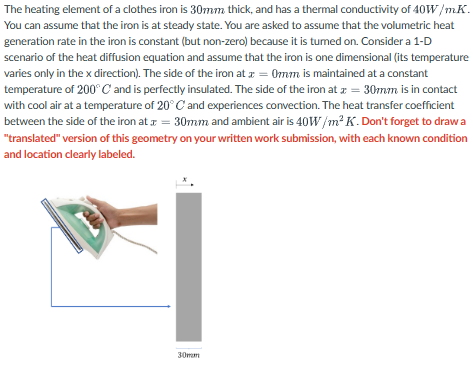c) What is the temperature of the iron heating element at x=30mm (in ∘C)? Use the origin defined in the given diagram. d) At which position x (in mm) does the iron heating element experience its highest temperature? e) In this scenario outlined in this question (constant heat generation under steady-state, 1-D conditions), can the temperature distribution in the iron ever be linear? Yes or No? Justify your reasoning.
c) What is the temperature of the iron heating element at x=30mm (in ∘C)? Use the origin defined in the given diagram. d) At which position x (in mm) does the iron heating element experience its highest temperature? e) In this scenario outlined in this question (constant heat generation under steady-state, 1-D conditions), can the temperature distribution in the iron ever be linear? Yes or No? Justify your reasoning.
Principles of Heat Transfer (Activate Learning with these NEW titles from Engineering!)
8th Edition
ISBN:9781305387102
Author:Kreith, Frank; Manglik, Raj M.
Publisher:Kreith, Frank; Manglik, Raj M.
Chapter3: Transient Heat Conduction
Section: Chapter Questions
Problem 3.7P
Related questions
Question
c) What is the temperature of the iron heating element at x=30mm (in ∘C)? Use the origin defined in the given diagram.
d) At which position x (in mm) does the iron heating element experience its highest temperature?
e) In this scenario outlined in this question (constant heat generation under steady-state, 1-D conditions), can the temperature distribution in the iron ever be linear? Yes or No? Justify your reasoning.

Transcribed Image Text:The heating element of a clothes iron is 30mm thick, and has a thermal conductivity of 40W/mK.
You can assume that the iron is at steady state. You are asked to assume that the volumetric heat
generation rate in the iron is constant (but non-zero) because it is tumed on. Consider a 1-D
scenario of the heat diffusion equation and assume that the iron is one dimensional (its temperature
varies only in the x direction). The side of the iron at x = 0mm is maintained at a constant
temperature of 200°C and is perfectly insulated. The side of the iron at x = 30mm is in contact
with cool air at a temperature of 20° C and experiences convection. The heat transfer coefficient
between the side of the iron at = 30mm and ambient air is 40W/m²K. Don't forget to draw a
"translated" version of this geometry on your written work submission, with each known condition
and location clearly labeled.
30mm
Expert Solution
Step 1
(c)
Write the given data.
Step by step
Solved in 3 steps with 1 images

Knowledge Booster
Learn more about
Need a deep-dive on the concept behind this application? Look no further. Learn more about this topic, mechanical-engineering and related others by exploring similar questions and additional content below.Recommended textbooks for you

Principles of Heat Transfer (Activate Learning wi…
Mechanical Engineering
ISBN:
9781305387102
Author:
Kreith, Frank; Manglik, Raj M.
Publisher:
Cengage Learning

Principles of Heat Transfer (Activate Learning wi…
Mechanical Engineering
ISBN:
9781305387102
Author:
Kreith, Frank; Manglik, Raj M.
Publisher:
Cengage Learning